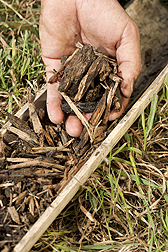 Trenches filled with wood chips can trap excess nitrogen and significantly stem nitrate flow from crop fields into the surrounding watershed, according to Agricultural Research Service studies.
Trenches filled with wood chips can trap excess nitrogen and significantly stem nitrate flow from crop fields into the surrounding watershed, according to Agricultural Research Service studies.Nitrates that leach out from Midwestern crop fields are channeled via underground tile drains, constructed by early settlers to drain soggy prairies, into nearby surface waterways. These nitrates can eventually end up in the Gulf of Mexico and feed the development of oxygen-deficient "dead zones."
Microorganisms that live in wood, however, use a process called denitrification to convert those nitrates flowing from the field into nitrogen gas or nitrous oxide, which then diffuse into the atmosphere.
ARS microbiologist Tom Moorman and others at the agency's National Laboratory for Agriculture and the Environment in Ames, Iowa installed perforated plastic drainage pipes four feet below the soil surface of experimental crop fields. Then they dug trenches on either side of the pipes and filled the trenches with wood chips. They buried the trenches and the pipes, and then cropped the fields with a corn-soybean rotation for the next nine years.
Over the nine-year study period, the team found that the wood chip "bioreactors" consistently removed nitrates from the leachate - the solution formed by the leaching from the field. From 2001 to 2008, annual nitrate loss in plots with conventional drainage averaged 48.6 pounds per acre, but losses dropped to 21.8 pounds per acre in plots with the denitrification walls.
Compared to subsoil, the average denitrification potential of wood increased from 31-fold in 2003 to 4,000-fold in 2004.
The scientists also found that 50 percent of the wood buried between 35 and 39 inches deep had decomposed five years after it was buried, and that 75 percent of the wood buried at this depth decomposed after nine years.
These findings can help in the design of denitrifying wood trenches, since wood decomposition rates will be needed to calculate the functional life expectancy of a denitrification wall after it is installed.
Sources:
Agricultural Research Service